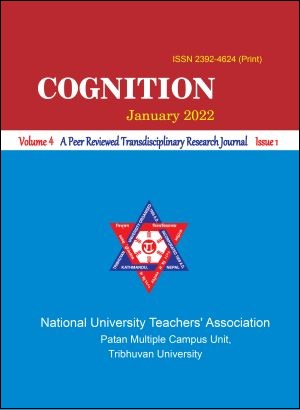‘ऋतु फेरिँदै जान्छ’ कथाको समाजशास्त्रीय विश्लेषण {Sociological Analysis of the Story 'ritu Fherindai Jancha'}
DOI:
https://doi.org/10.3126/cognition.v4i1.46804Keywords:
Brahmanism, ब्राह्मणवाद, सर्वसत्तावाद, Totalitarianism, परावैयक्तिक, Parapersonalism, अधीनस्थ, समानधर्मिता, Subordinationism, HomotheismAbstract
प्रस्तुत आलेख इन्द्रकुमार श्रेष्ठ ‘सरित्’ द्वारा लेखिएको ‘ऋतु फेरिंदै जान्छ’ कथामा व्याप्त शोषण, दमन,छल र जातीय छुवाछुत जस्तो सामाजिक विषयवस्तुमा आधारित छ । ‘ऋतु फेरिंदै जान्छ’ कथामा अभिजात वर्ग र शोषित पीडित दलितको आ–आफ्नो वर्गीय दृष्टिकोण कसरी अभिव्यक्त भएको छ । प्रभुत्वशाली वर्गसँग श्रमिक र सीमान्तकृत दलितको प्रतिरोधी चेतनाको विकास र प्रतिरोधको स्थिति देखाउने प्रयासमा केन्द्रित छ । यसका लागि लुसिएँ गोल्डमानको विश्वदृष्टि सम्बन्धी मान्यतालाई कथा विश्लेषणको मुख्य आधार बनाएको छ । शोषक सामन्तको प्रतिनिधि पात्र पण्डित हरिशङ्कर छन् । गरिबमारा, सामन्तवादी र यथास्थितिवादी विश्वदृष्टि पण्डितको रहेको छ । गरिब, दलित र श्रमिकको प्रतिनिधि पात्र जुठे दमाई हो; उसको प्रतिरोधी चेतना रूपान्तरणको प्रयत्नभित्र समता र मर्यादाको लागि लड्ने क्रान्तिकारी विश्वदृष्टि छ । शोषक र श्रमिक कथित अछुत र अभिजात्य वर्गको दुई विपरीत विचारधारात्मक सङ्घर्षको सेरोफेरोमा कथा बुनिएको छ । दुई फरक समुदायको विश्वदृष्टिकोण मासंरचनाको समान धर्मितासमेत कायम गरेको पाइन्छ । यो कथाको शीर्षक नै बिम्बात्मक रूपमा समय परिवर्तनशील रहेको सन्देश प्रवाह गर्न सफल छ ।
{The presented article is based on social themes such as exploitation, oppression, deception and caste untouchability prevalent in the story "Ritu Ferindai Jaya" written by Indra Kumar Shrestha 'Sarit'. In the story 'Ritu Ferindai Jaya', how are the respective class views of the elite class and the oppressed victim Dalit expressed. It focuses on the development of the resistance consciousness of workers and marginalized Dalits against the dominant class and efforts to show the position of resistance. For this, the worldview of Lucien Goldman has been made the main basis of narrative analysis. Pandit Harishankar is the representative character of the exploitative feudal lord. Pandit has a poor, feudalistic and status quo worldview. The representative character of the poor, Dalits and workers is Juthe Damai; He has a revolutionary worldview of fighting for equality and dignity within the effort to transform the resistant consciousness. The story is woven in Serofero of the two opposite ideological struggles of the exploiters and laborers, the so-called untouchables and elites. The world view of two different communities has been maintained in the same structure. The title of this story is successful in conveying the message that time is changing in a symbolic way.}




